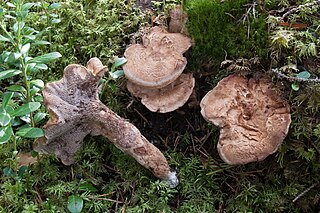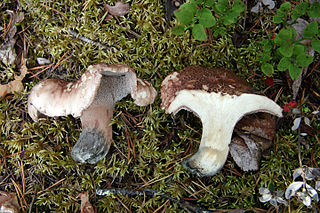
Inocybe hystrix is an agaric fungus in the family Inocybaceae. It forms mycorrhiza with surrounding deciduous trees. Fruit bodies are usually found growing alone or in small groups on leaf litter during autumn months. Unlike many Inocybe species, Inocybe hystrix is densely covered in brown scales, a characteristic that aids in identification. The mushroom also has a spermatic odour that is especially noticeable when the mushroom is damaged or crushed.

Hydnellum peckii is a fungus in the genus Hydnellum of the family Bankeraceae. It is a hydnoid species, producing spores on the surface of vertical spines or tooth-like projections that hang from the undersurface of the fruit bodies. It is found in North America, Europe, and was recently discovered in Iran (2008) and Korea (2010). Hydnellum peckii is a mycorrhizal species, and forms mutually beneficial relationships with a variety of coniferous trees, growing on the ground singly, scattered, or in fused masses.

Cortinarius caperatus is an edible mushroom of the genus Cortinarius found in northern regions of Europe and North America. It was known as Rozites caperata for many years before genetic studies revealed that it belonged to the genus Cortinarius. The fruit bodies appear in autumn in coniferous and beech woods as well as heathlands in late summer and autumn. The ochre-coloured cap is up to 10 cm (4 in) across and has a fibrous surface. The clay-colored gills are attached to the stipe under the cap, and the stipe is whitish with a whitish ring. The Latin specific name, caperatus, means wrinkled, and refers to the distinctive texture of the cap. The flesh has a mild smell and flavor.

Hydnellum is a genus of tooth fungi in the family Bankeraceae. Widely distributed in the Northern Hemisphere, the genus contains around 40 species. The fruitbodies of its members grow by slowly enveloping nearby bits of grass and vegetation. There is great variability in the form of Hydnellum fruitbodies, which are greatly influenced by environmental conditions such as rainfall and humidity, drying winds, and temperature. They are too tough and woody to eat comfortably. Several species have become the focus of increasing conservation concern following widespread declines in abundance.

Phellodon is a genus of tooth fungi in the family Bankeraceae. Species have small- to medium-sized fruitbodies with white spines on the underside from which spores are released. All Phellodon have a short stalk or stipe, and so the genus falls into the group known as stipitate hydnoid fungi. The tough and leathery flesh usually has a pleasant, fragrant odor, and develops a cork-like texture when dry. Neighboring fruitbodies can fuse, sometimes producing large mats of joined caps. Phellodon species produce a white spore print, while the individual spores are roughly spherical to ellipsoid in shape, with spiny surfaces.

Hydnellum aurantiacum is an inedible fungus, commonly known as the orange spine or orange Hydnellum for its reddish orange or rusty red colored fruit bodies. Like other tooth fungi, it bears a layer of spines rather than gills on the underside of the cap. Due to substantial declines in sightings, this species is listed as critically endangered in the United Kingdom.

Mycena cinerella, commonly known as the mealy bonnet, is an inedible species of mushroom in the family Mycenaceae. It is found in Europe and the United States, where it grows in groups on fallen leaves and needles under pine and Douglas fir. The small grayish mushrooms have caps that are up to 1.5 cm (0.6 in) wide atop stipes that are 5 cm (2.0 in) long and 2.5 mm (0.10 in) thick. Its gills are grayish-white and adnate, with a "tooth" that runs slightly down the stipe. The fungus has both two- and four-spored basidia. As its common name suggests, it smells mealy.

Hydnellum ferrugineum, commonly known as the mealy tooth or the reddish-brown corky spine fungus, is a species of tooth fungus in the family Bankeraceae. A widely distributed species, it is found in north Africa, Asia, Europe, and North America. The fungus fruits on the ground singly or in clusters in conifer forest, usually in poor or sandy soil. Fruit bodies are somewhat top-shaped, measuring 3–10 cm (1–4 in) in diameter. Their velvety surfaces, initially white to pink, sometimes exude drops of red liquid. The lower surface of the fruit body features white to reddish-brown spines up to 6 mm long. Mature fruit bodies become dark reddish brown in color, and are then difficult to distinguish from other similar Hydnellum species. H. ferrugineum forms a mat of mycelia in the humus and upper soil where it grows. The presence of the fungus changes the characteristics of the soil, making it more podzolized.

Hydnellum geogenium is a species of tooth fungus in the family Bankeraceae. It was described as new to science in 1852 by Elias Magnus Fries. Howard James Banker transferred it to the genus Hydnellum in 1913. The fungus is found in Europe and North America, where it grows in coniferous woods. It is inedible. H. geogenium is considered endangered in Switzerland. Fruitbodies of the fungus contain a yellow pigment compound called geogenin.

Hydnellum compactum is a tooth fungus in the family Bankeraceae. It is found in Europe, where it grows in deciduous forest, typically under beech. Fruit bodies of the fungus grow singly or in groups. They are top-shaped, with convex or flattened upper surfaces up to 10 cm (4 in) in diameter. The surface texture is initially felt-like before becoming pitted and rough in age. The stipe, roughly the same color as the cap, is solid and measures 2–4 cm (0.8–1.6 in) long by 1–3 cm (0.4–1.2 in) thick. On the fertile cap underside are white to purple-brown, curved spines up to 5 mm long. The color is whitish at first but gradually turns dark brown to blackish. Its spores measure 5.5–6 by 3.5–4.5 µm, and feature tubercles that sometimes have a sunken tip. It is considered endangered in Switzerland.

Hydnellum mirabile is an inedible species of tooth fungus in the family Bankeraceae. It is found in Europe and North America, where it grows on the ground in forested areas. Caps are brownish to dark brown with yellow edges, and have a hairy surface. On the cap underside hang brownish spines with paler tips. The spores are roughly spherical with tubercles on the surface, and measure 5–7 by 4.5–6 µm.

Hydnellum cyanopodium, commonly known as the blue foot or bleeding blue tooth, is an inedible fungus in the family Bankeraceae. It occurs in the Pacific Northwest region of North America.

Hydnellum scrobiculatum, commonly known as the ridged tooth, is a tooth fungus in the family Bankeraceae. Widely distributed in the Northern Hemisphere, it is found in Asia, Europe, and North America.
Hydnellum conigenum, commonly known as the funnel hydnum, is a species of tooth fungus in the family Bankeraceae found in North America. It was first described in 1903 by American mycologist Charles Horton Peck from collections made growing on fallen cones of ponderosa pine, near the base of the Moscow Mountains. Peck thought it was similar to H. aurantiacum, differing in its smaller size, more slender stipe, non-zoned flesh, more even cap, and somewhat unusual substrate. Howard James Banker transferred it to the genus Hydnellum in 1906. Its range extends from New Mexico to British Columbia and the Great Lakes region, where it grows in coniferous forests.

Phellodon niger, commonly known as the black tooth, is a species of tooth fungus in the family Bankeraceae, and the type species of the genus Phellodon. It was originally described by Elias Magnus Fries in 1815 as a species of Hydnum. Petter Karsten included it as one of the original three species when he circumscribed Phellodon in 1881. The fungus is found in Europe and North America, although molecular studies suggest that the North American populations represent a similar but genetically distinct species.

Hydnellum amygdaliolens is a species of tooth fungus in the family Bankeraceae. Found in the Iberian Peninsula, it was described as new to science in 2011. It smells strongly of bitter almonds. Its spores measure 5.25–6.5 by 4.5 μm.

Hydnellum joeides is a species of tooth fungus in the family Bankeraceae.

Hydnellum fennicum is a species of tooth fungus in the family Bankeraceae. It was originally described by Petter Karsten in 1882 as a variety of Sarcodon scabrosus. Karsten promoted it to a distinct species in 1887. It is considered critically endangered in Switzerland. It is inedible.
Mycorrhaphium pusillum is a species of tooth fungus in the family Steccherinaceae. It is a rare European fungus that has only been officially recorded a few times.

Hydnellum scabrosum, also called bitter tooth or bitter hedgehog, is a species of tooth fungus in the family Bankeraceae.

















